#picts
Text
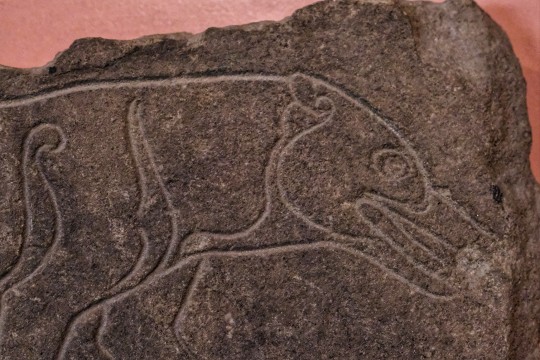

The Pictish Wolf Stone, Stittenham, Ardross, Inverness Museum and Gallery, Scotland
#pictish stones#pict#picts#pictish#Pictish wolf#wolf stone#Pictish art#archaeology#symbols#ancient living#ancient craft#ancient culture#Scotland#wolf#beast
7K notes
·
View notes
Text
The Evil Little Hairy Cave People of Europe in Pulp Fiction

From the 1900s to the 1940s, there was a trendy theme in occult and horror stories that the explanation for widespread European legends of fairies, brownies, pixies, leprechauns and other malicious little people, was that they were a hereditary racial memory of the extremely small non-human, hairy stone age original inhabitants of Europe, who still survive well into modern times in caves and barrows below the earth. Envious of being displaced on the surface, these weird creatures, adapted to the darkness of living underground and unable to withstand the sun, still mean mischief and occasionally go out at night to capture someone.... usually an attractive woman....to take to their dark caves for human sacrifice.
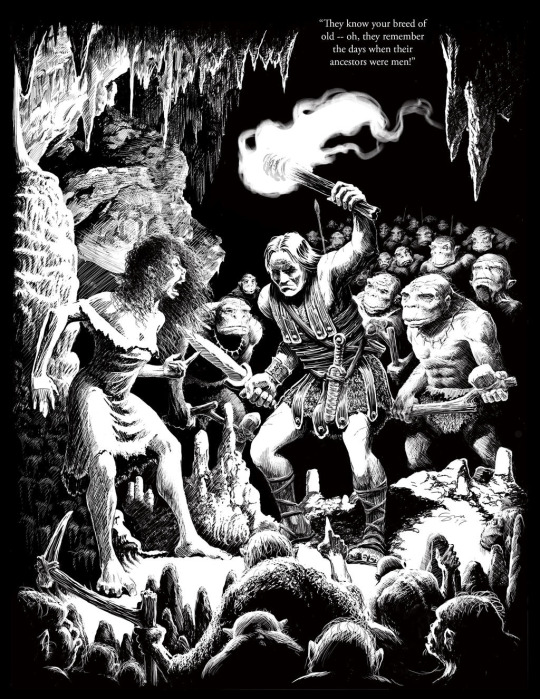
Displaced by the arrival of Indo-European language speakers at the dawn of the Bronze Age, these original, not quite human stone age people of Europe were driven deep underground into caves and barrows below the earth, where they went mad, adapted to the darkness and acquired a fear of daylight, became extremely inbred, in some cases acquired widespread albinism. It is these strange little people who gave the descendants of Europeans a haunting racial dread of places below the earth like mines and caves, and it also is these strange, hairy troglodytes who originally built the uncanny and mysterious menhir, fairy rings, and stone age structures of England, Scotland, and Ireland that predate the coming of the Celts and Romans.
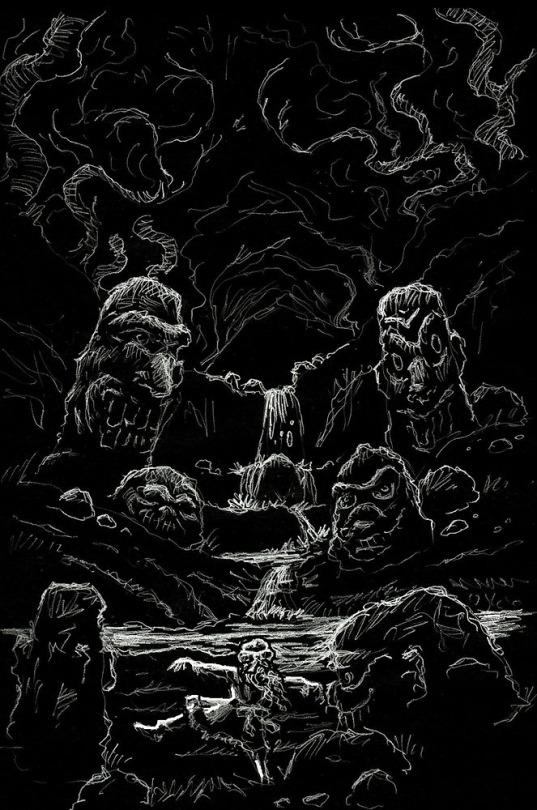
In some cases, these evil troglodytes are usually identified with the mysterious Picts, the pre-Celtic stone age inhabitants of the British Isles. In some cases, they are identified with the Basque people of Spain, best known as the inventors of Jai Alai, and the oldest people in Europe who speak a unique language unrelated to any in the world.
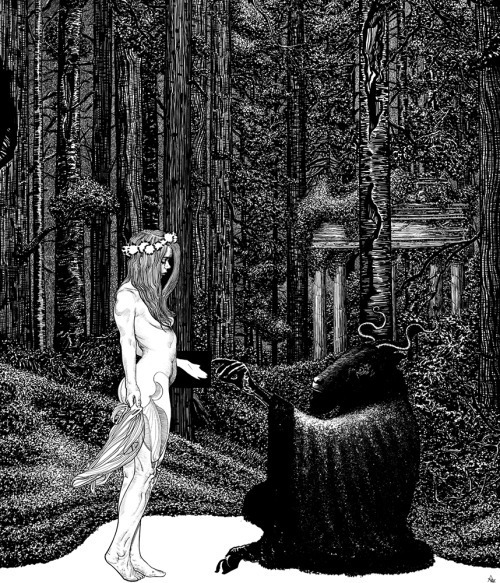
The original codifier of this trend was Arthur Machen, a horror writer who is less remembered than his contemporary, Henry James, but who may be the best horror writer in the generations between Poe on the one end and Lovecraft/CL Moore/Clark Ashton Smith on the other. His story, "the White People" from 1904 (a reference to their strange cave albinism) was a twisted Alice in Wonderland with a girl who is irresistibly attracted to dark pre-Roman stone age ruins and who is eventually pulled underground.
In addition to being a great horror writer, Arthur Machen was a member of the Hermetic Society of the Golden Dawn, an occult organization, and was often seen at the Isis-Urania Temple in London. Many of his works have secretive occult knowledge.
H.P. Lovecraft in particular always pointed out Arthur Machen as his single biggest inspiration, though he combined Machen's dread and occultism with Abraham Merritt's sense of fear of the cosmic unknown, seen in "Dwellers in the Mirage" and "People of the Pit."

Another and scarier example of this trend would be "No Man's Land," a story by John Buchan, a Scotsman fascinated by paganism and horror, who often wrote stories of horrific discoveries and evil rites on the Scottish moors. He is often reduced to being described as a "Scottish Ghost Story" writer, a painfully reductivist description as in his career, Buchan wrote a lot of thrillers, detective, and adventure stories as well. In later life, he was appointed Governor General of Canada, meaning he may be the first head of state to be a horror writer.
It was Buchan who first identified the cave creatures with the Picts, something that another Weird Tales writer decades later, Robert E. Howard, would roll with in the 1920s.

Howard is a very identifiable kind of modern person you often see on the internet: a guy who talks tough, but who was terrified to leave his small town. He created manly man, tough guy heroes like Conan the Barbarian, Kull, and El Borak, but he himself never left his mother's house. It's no wonder he got along well with his fellow Weird Tales writer and weird shut in, HP Lovecraft. With 1920s Weird Tales writers, despite your admiration for their incredible talent, you also can't help but laugh at them a little, a feeling you also apply to a lot of Victorians, who achieved incredible things, but who are often closet cases and cranks who died virgins ("Chinese" Gordon comes to mind, as does Immelmann).
With Howard, his obsession with the Picts and the stone age cave dwelling people of Europe started with an unpublished manuscript where at a dinner party, a man gets knocked out and regresses to his past life in the Bronze Age, where he remembers the earliest contact between modern humans and the original inhabitants of the British Isles, the evil darkskinned Picts. This is a mix of both the "little cave people" story and another cliche at the time, "the stone age past life regression novel," another turn of the century cliche.
Still with the Picts on his mind, Howard would later create Bran Mak Morn, a Pict chieftain, who predated Kull and Conan as his Celtic caveman muscle hero. Howard was of Irish descent and proudly anti-Colonial and anti-British, with his Roman Empire and Civilized Kingdoms as a stand in for the British and other Empires, which he viewed as rapacious and humbug, a view shared by his greatest inspiration, Talbot Mundy. His "Worms of the Earth" gets to the heart of why these little cave people scare us so much: they remind us that we live on land that is impossibly ancient and we don't fully understand at all.

It was another Weird Tales Writer a decade later who wrote one of the last stories about the little hairy cave people of Europe, though, Manly Wade Wellman in 1942. Wellman was mainly known for creating the blond beefcake caveman hero Hok the Mighty set in stone age times, and for his supernatural ghost stories of Silver John the Balladeer set in modern, ghostly Appalachia (like many ex-Weird Tales writers, he made a turn to being a regional author in his later career, in the same way Hugh B. Cave became a Caribbean writer), but Wellman also had a regular character known as John Thunstone, a muscular and wealthy playboy known for his moustache who used his great wealth to investigate the supernatural and the occult. Thunstone had a silver sword made by St. Dunstan, patron of Silversmiths, well known for his confrontations with the Devil.
Most John Thunstone stories featured familiar stories, like a demon possessed seance and so on, but one in particular featured a unique enemy, the Shonokins.
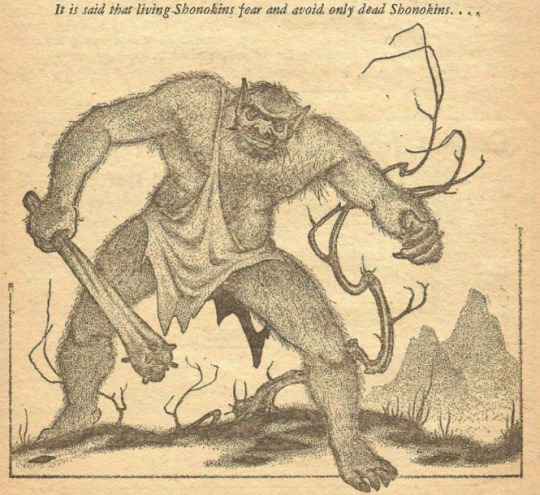
The Shonokins were the original rulers of North America, descendants of Neanderthal man displaced by American Indians. This fear that the land we live is ancient and unknowable and we just arrived on it and don't know any of its secrets is common to settler societies, who often hold the landscape with dread, as in Patricia Wrightson's fantasies of the Australian Outback. It was easy enough to transport the hairy cave people from the Scottish Moors to North America. I suspect that's what they are, a personification of a fear shared in the middle class, that in the back of their minds, that everything they have supposedly earned is merely an accident of history, built by rapacity and the crimes of history, and that someday a bill will come due.
A text page in the May 1942 issue of Weird Tales gives strange additional information on the Shonokins not found elsewhere:
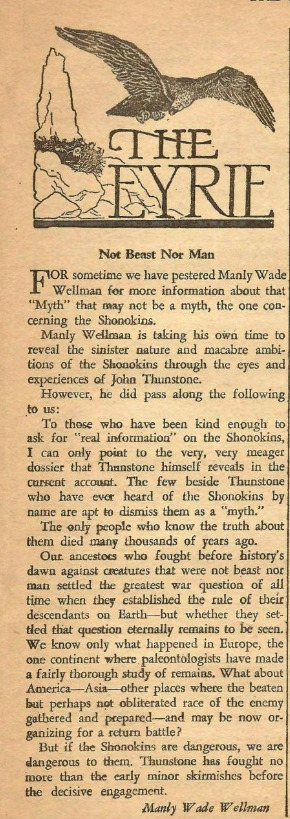
Since then, there have been too many examples of evil cave people who predate Europeans. Philip Jose Farmer's "The All White Elf" features the last survivor of a pre-European people who live in caves. A lot of other fiction of course has featured the Picts, but according to our modern scientific understanding, which describes them as much, much less exotically, as a blue tattooed people not too different and practically indistinguishable from the Celtic tribes that surrounded them, and which they eventually blended into.
414 notes
·
View notes
Text

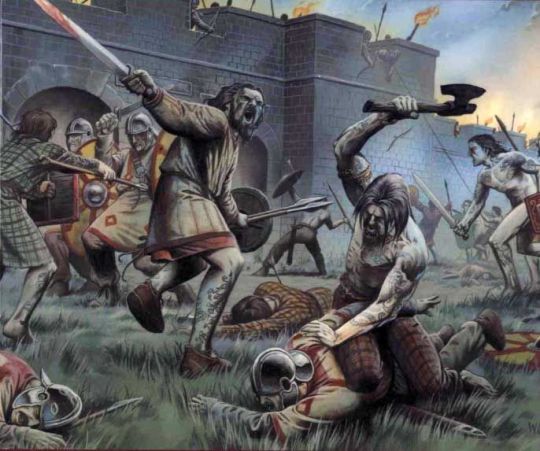

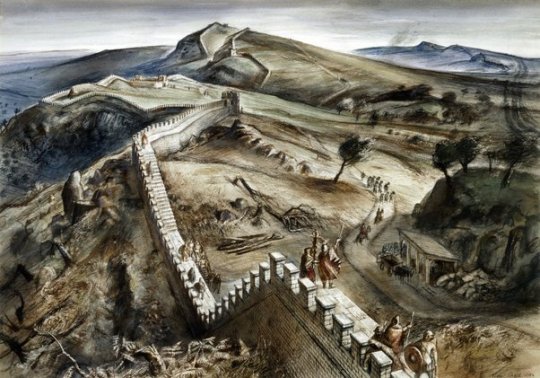
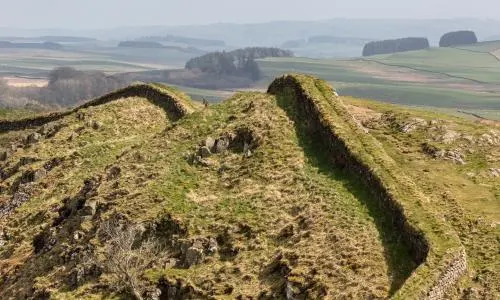
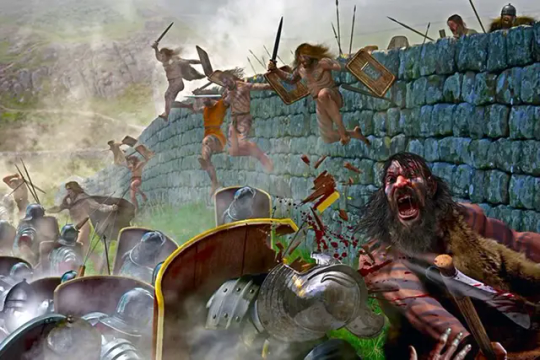


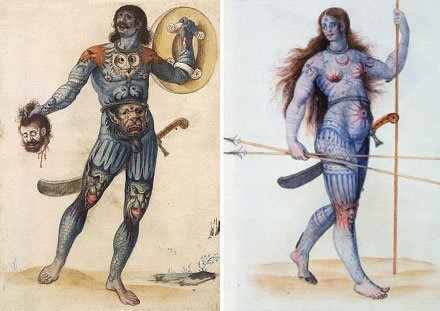
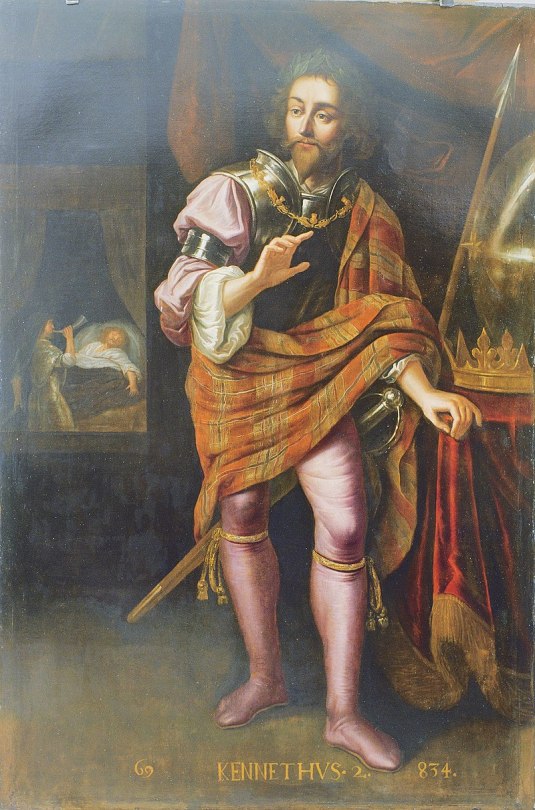
January 24th, 76AD, is said to be the likely date of birth forPublius Aelius Hadrianus, who built Hadrian’s Wall.
When the Romans invaded the British Isles they held, large parts of what is now Scotland, even after the construction of Hadrian’s Wall in AD 122, there were large forts around the country at varioustimes, the largest of which was Trimontium located at Newstead, near Melrose, in the Scottish Borders. It was occupied intermittently from about 79 to 184 AD and was the largest of the "outpost" forts after the construction of Hadrian's Wall
Hadrian’s Wall was largely abandoned for about twenty years from .AD 138, when the Romans established a new frontier in Scotland between what are now the Firths of Forth and Clyde, where they built the Antonine Wall.
The Antonine Wall was more of a very large ditch, and my old flat would have been part of the structure, part of the "wall" is on land only yards from me. I got into trouble for calling it a ditch from a Roman historian before, so will add that it was much more, the thing is it more or less looks like one just now, much of the fortifications are long gone.
Hadrian is noted for his interest in architecture and the number of provinces he visited whilst Emperor. He is likely to have visited Britain in AD 122, after some kind of conflict in the preceding years, and we know that it was in this period that construction of the Wall started. It has also been known as Picts' Wall, or Vallum Hadriani in Latin.
The origin of the Picts is clouded by the many fables and legends about them. There are numerous theories as to who the Picts were and where they came from. Experts even disagree over what they ate and drank and what language they spoke although some point to the existence of a distinct Pictish language, which today is believed to have been an Insular Celtic language, closely related to the Brittonic spoken by the Britons who lived to the south.
Often described as savages the Picts were an ancient and artistic people who defied the might of Rome which conquered the rest of Britain. They were a sophisticated , hardworking, clever people, skilled in farming and fishing.
You would have thought a savage tribe would have been an easy conquest for the Romans, but the Picts were anything but that. Picts are first recorded in history in the third century AD. Eumenius, a Roman writer, describes the "pictus" as fierce and skilled in battle. It is not clear whether "pictus" (the Latin for painted) was intended, or if this is a Latin form of some indigenous name. I prefer to think of them as the "Painted People"
Although the Romans reached Scotland and often defeated them in battle, they never conquered the Picts or Pictland. The Roman Empire's expeditions north resulted in few permanent gains.
Scotland's sculptured stones, created by the Picts of ancient Alba tell the stories of a race of people who defied Rome and survived the invading Vikings, thus preserving a separate culture and race in Scotland. It is in these sometimes mighty, sometimes delicate stones that the history of ancient Scotland is now recorded.
There are many of these slabs on display in The National Museum of Scotland in Edinburgh, as well as a fine display in The Hunterian in Glasgow.
When the Romans left the Picts were often attacked by the Britons and eventually all the Pictish tribes agreed to support one High King who would rule all of Pictland.
It's said the Picts, unusually, were a matrilineal society, i.e. bloodlines passed through the mother. Pictish kings were not succeeded by their sons, but by brothers, nephews or cousins as traced by the female line in a complicated series of intermarriages between 7 royal houses. It is this rare form of succession which in 845 AD gave the crown of Alba and the title Rex Pictorum - King of the Picts - to the son of a Pictish princess by the name of Kenneth, Son of Alpin, he is generally accepted by most historians as the first of the kings of Scotland, follwing on from his reign as King of Dál Riata. As usual though, not al agree on this.
The Picts survived as a distinct people until early in the 10th century. However, there is no record of them dying out or moving elsewhere. It is most likely that the Picts simply integrated into the large population within the developing multi-ethnic nation of Scotti, Picts, Celts, Britons and Angles which we now call Scotland. The map, from wiki says this was how their lands looked as late as the 7th century. The last pics are of two Pictish people and a 15th century depiction of King Kenneth.
173 notes
·
View notes
Text

A hoard of Roman nails found at Inchtuthil, Perth and Kinross, Scotland, circa 87 AD. After the Roman army abandoned their forward fortification on the site they buried 875,400 iron nails on the site to prevent the enemy Caledonian tribes reforging the iron for weapons.
606 notes
·
View notes
Photo
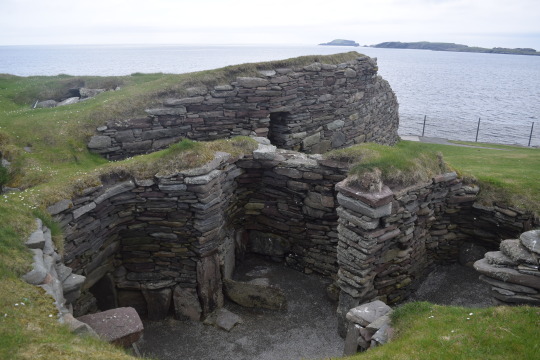

Jarlshof // Shetland
#viking#pictish#settlement#historic scotland#norse#norseman#picts#kiteknots#nikon#nikonnofilter#unedited#nikon photography#dslr#nikon d5300#nature photography#photography#photography blog#unedited photography#nature blog#shetland#scotland#scottish islands#scottish#shetland islands#sea#greenspace#ocean#coast#coastal#island
746 notes
·
View notes
Text
Time Travel Question : Medievalish History 8 and Earlier
These Questions are the result of suggestions from the previous iteration.
This category may include suggestions made too late to fall into the correct earlier time grouping. Basically, I'd already moved on to human history, but I'd periodically get a pre-homin suggestion, hence the occasional random item waaay out of it's time period, rather than reopen the category.
In some cases a culture lasted a really long time and I grouped them by whether it was likely the later or earlier grouping made the most sense with the information I had. (Invention ofs tend to fall in an earlier grouping if it's still open. Ones that imply height of or just before something tend to get grouped later, but not always. Sometimes I'll split two different things from the same culture into different polls because they involve separate research goals or the like).
Please add new suggestions below if you have them for future consideration. All cultures and time periods welcome.
#Neolithic#Anatolian#Ancient World#Bible#Isaiah#Prophets#Phoenicians#Proto-Ancient Religion#Pre-Mamluk#Hinduism#History of Religion#History of India#Middle Ages#Religious History#The Pictish Beast#Picts#History of Music#Cathedrals#1000 BCE#Ancient Israel#Slavic People#100 BCE#Petroglyphs#Paleolithic
55 notes
·
View notes
Text
Rare medieval script discovered on stone carved by Scotland's 'Painted People'
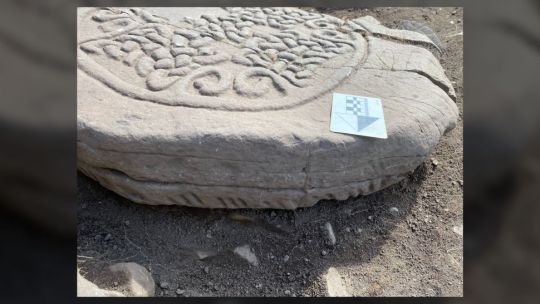
Archaeologists and volunteers have discovered a stone bearing a mysterious inscription and carved birds that the Picts of Scotland crafted more than a millennium ago. The cross slab, found in a small cemetery last month, dates to between A.D. 500 and 700, and sheds new light on the historic interaction between heritage and faith in the northern U.K.
The Picts, or "Painted People," were so-named by Roman historians because of their supposed war paint and tattoos ("picti," is the Latin word for "paint"). They lived in northern and eastern Scotland in the early medieval period. Likely descended from Celtic tribes, the Picts are famous for successfully resisting Roman conquest. While the Romans painted the Picts as barbarous and backward, they were largely subsistence farmers, growing grain and herding domesticated animals. Read more.
546 notes
·
View notes
Text
The Scottish Picts, an enigmatic tribe that challenged Romans, excelling in seafaring and guerrilla #warfare. Despite ultimately being assimilated, their genetic legacy endures in 10% of Scottish males.
35 notes
·
View notes
Photo

Legends and myths about trees
Celtic beliefs in trees (17)
U for Ura (Heather) - June 21st Summer Solstice
“Flowers of Passion - Summer Solstice in the Celtic Tree Calendar (Ref)”
Star: Mars, Venus; Gemstone: garnet; Gender: female; Patron: Erecura (Aerecura), Venus, Cybele, Isis, Arecurius (or Aericurus); Symbol: passion
In the height of summer, it is hard not to be moved by the lustrous spectacle of heather flowers as they colour the moorlands and hillsides from pale lilac to red.
For the passionate Celts, the heather flower was a harbinger of joy and indulgence. With the fragrant scent of heather carried on the breeze, and the richness of heather honey, the Celts would give off an extra burst of joy when summer arrived with ale made from the heather flower. This legendary ancient brew was an essential drink in the Scottish Highlands and Western Isles, where people drank it from cups made of bull's horns.
The legendary bard and wizard Taliesin, in his ancient Welsh poem, The Battle of the Trees (Cad Goddeu), praises the heather as 'a comforter to a people in distress'. He claims that this legendary drink has the power to restore vitality.
The Picts (a group of people who lived in Britain north of the Forth Clyde isthmus in the early Middle Ages) used to make a very pleasant strong ale from heather. Legend has it that during the massacre of the Picts in the 4th century, the last surviving Pictish man was offered his life if he would teach how to brew heath ale, but he refused stubbornly the offer and threw himself off a cliff to his death.
Fever, carnal pleasures and unbridled pleasure are what Heather symbolises, but there is a deep lesson lurking in the pleasures. That is the 'consequence' that unchecked passion sometimes causes. So the Celts believed that before drinking heather ale, you should be aware of who you really are.
Between self-expression and self-control, Heather teaches, there is joy in living only when you live in balance between the two.
[Image below by Windermere Brewing Co.]

木にまつわる伝説・神話
ケルト人の樹木の信仰 (17)
UはUra (ヒース) - 6月21日・夏至
『情熱の花 〜 ケルトの木の暦(参照)夏至』
星: 火星、金星; 宝石:ガーネット; 性別:女性; 守護星:エレクラ(エーレクラ)、ヴィーナス、キュベレー、イシス、アレクリウス(またはエアキュロス); 象徴:情熱
夏たけなわのこの季節、ヒースの花がムーア地帯や山腹を、淡いライラック色から赤まで染めていく、艶やかな光景に心を動かされない人はいないでしょう。
情熱的なケルト人にとって、ヒースの花は喜びと贅沢の前触れだった。そよ風に乗って運ばれてくるヒースのかぐわしい香り、そして濃厚なヒースの蜂蜜…夏を迎えると、ケルト人は、ヒースの花からつくったエールをあおり、さらに喜びを爆発させた。古代から伝わるこの伝説の醸造酒は、スコットランドのハイランド地方や西部の島々にはなくてはならない飲み物で、人々は牛の角でできた杯で飲んだものであった。
伝説の吟唱詩人で魔法使いのタリエシンは、古代ウエールズの詩『木の戦い (カット・ゴザイ)』の中で、ヒースを「苦難の民を慰めるもの」として称えている。
もともとはピクト人(ヴァイキング以前の中世初期に、フォース・クライド地峡以北のブリテンに住んでいた人々)が、ヒースからとても心地よく強いエールを造っていた。伝説によれば、4世紀にピクト人が虐殺された際、最後に生き残ったピクト人は、ヒース・エールの造り方を教えれば命を与えると持ちかけられたが、頑なに拒否し、崖から身を投げて命を絶ったという。
熱狂や肉欲の愉しみ、そして奔放な快楽こそが象徴であるヒースだが、享楽には深い教えが潜んでいる。それは、無軌道な情熱がときとして引き起こす「結果」だ。だから、ヒース・エールを飲む前に、本当の自分とは何者なのか、よくわきまえておくべきだとケルト人は信じていた。
自己表現と自己抑制、この二つの間で、バランス良く生きてこそ、生きる喜びがあると、ヒースは教えている。
#trees#tree legend#tree myth#celtic belief#celtic calender#summer solstice#heather#flowers of passion#heather ale#picts#legend#folklore#nature#art#mythology
119 notes
·
View notes
Text
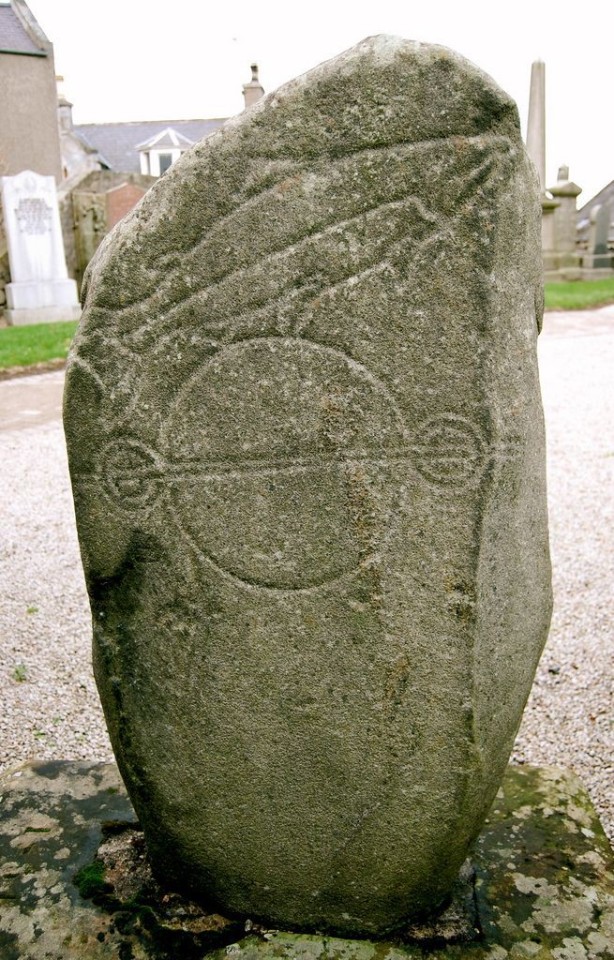
'Pictish Symbol Stone', located in Kintore, Aberdeenshire.
198 notes
·
View notes
Text
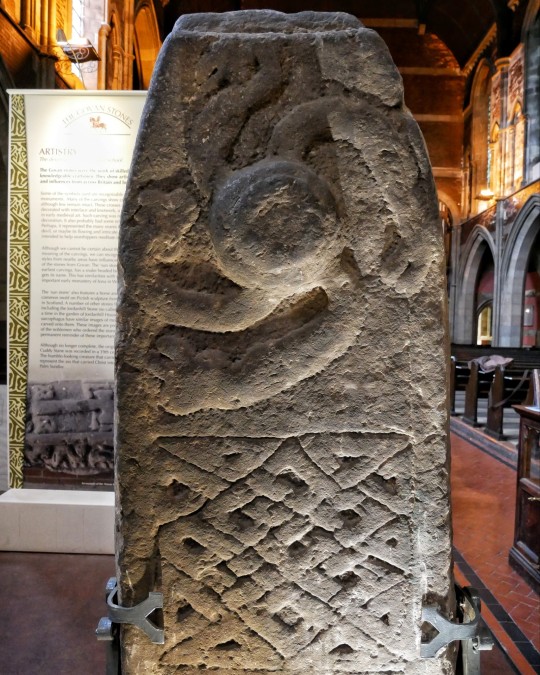
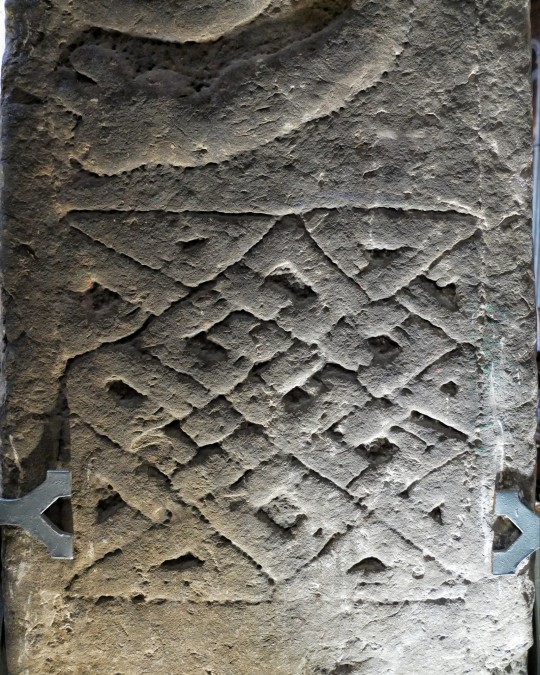


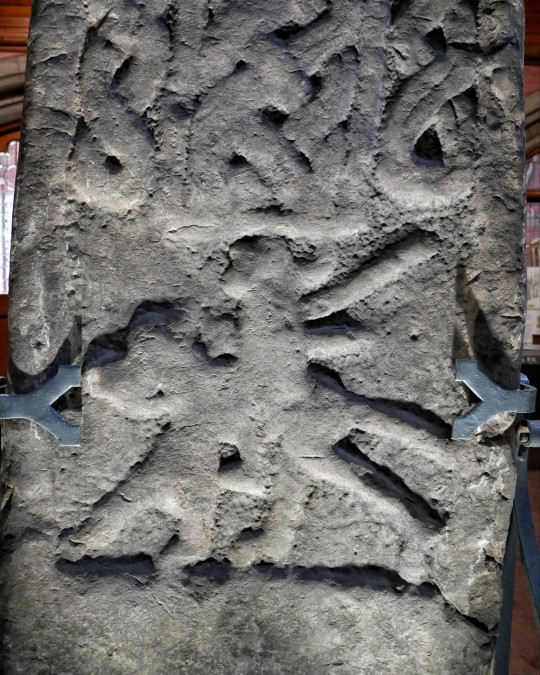

'The Sun Stone', Early Christian Cross with Pictish Influenced Design, Govan Old Stones Collection, Old Govan, Glasgow, Scotland
#early religion#Pictish#pict#picts#archaeology#ancient living#ancient craft#ancient culture#symbols#sun#sun motif#stonework#stone carving#Scotland#Glasgow#early christianity#cross shaft
473 notes
·
View notes
Link
33 notes
·
View notes
Text
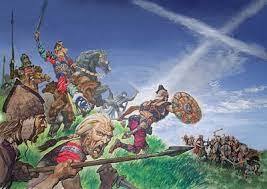

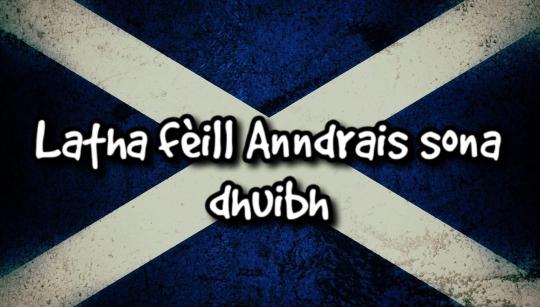
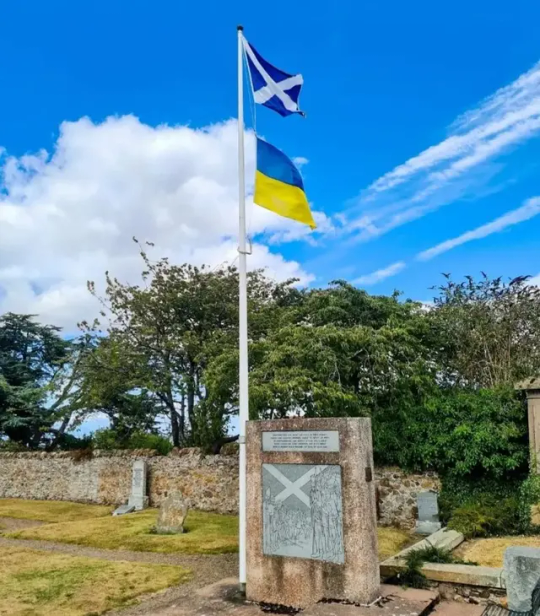

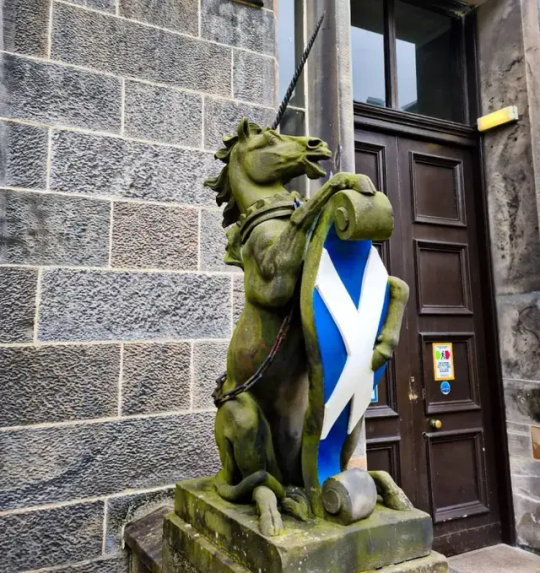
Happy St Andrews Day.
As part of our Patron Saint’s Feast Day the Scottish Saltire is proudly flown and many people add it to their posts on social media to celebrate the day, but how did Scotland adopt the saltire?
There is no actual date, or in fact nothing in our written history of the time, but legend has it that in AD 832 the king of the Picts, ‘Aengus MacFergus’, ( Anglified to Angus but some stories say Hungus) with the support of 'Scots’ from Dalriada, won a great battle against King Athelstane of the Northumbrians. The site of the legendary battle became known as Athelstaneford in present-day East Lothian.
St Andrew visited the Pictish leader in a dream before the battle and told him that victory would be won. When the battle itself was raging, a miraculous vision of the St Andrew’s Cross was seen shining in the sky, giving a boost to the morale and fighting spirit of his warriors. The result was a victory over the Saxons, and the death of Athelstan. Thus, after this victory, according to the tradition, the Saltire or St Andrew’s Cross became the flag of Scotland, and St Andrew the national patron saint.
While there is no written reference to the battle in Scotland from the period it was said to have taken place, this is not surprising, as it was a time for which we have little or no documentation for anything. The earliest written mention of the Battle of Athelstaneford in Scottish history comes from years later in the newspapers of the day, if you follow my posts then you know I dip into these “Chronicles from time to time, the first one to mention Athelstaneford is the Scotichronicon, written by the Scottish historian Walter Bower.
The Scotichronicon has been described by some Scottish historians as a valuable source of historical information, especially for the times that were recent to him or within his own memory. But he also wrote about earlier times, and this included the battle at Athelstaneford.
Bower’s account includes the scene where Aengus MacFergus is visited by St Andrew in a dream before the battle. He was told that the cross of Christ would be carried before him by an angel, there was no mention of a St Andrew’s Cross in the sky in this version. It was in later accounts, from the 16th centuries onwards, that we have the description of an image of St Andrew’s Cross shining in the sky
Bower was writing in the early 1400s. The bitter and bloody struggle to retain Scotland’s independence was not just a recent memory but also a current reality for him. Parts of Scotland were still occupied by England, and Bower had been involved in raising the money to release Scotland’s king, James I, from English captivity.
Also, Scotland’s early historical records and documents had been deliberately destroyed during the invasion by the English king Edward I. This was done in part as an attempt to remove historical evidence that Scotland had been an independent kingdom. The idea was simple: take away a nation’s history and you strip it of its identity and justification for its independent existence. The theft of the Stone of Destiny was part of this process, the Black Rood which was believed to contain a piece of the Cross Jesus was crucified on was also removed, I have covered both these in previous posts.
Part of Bower’s motivation in writing his Scotichronicon was to help restore this stolen history. He was a scholar and a man of the church. In his time, the figure of St Andrew had become a prominent presence in Scottish society.
The greatest church building in the land during his time was the Cathedral of St Andrew, which housed relics of St Andrew himself. It had taken over a hundred years to build and wasn’t formally consecrated until 1318, just four years after Bannockburn. The ceremony of course included Robert the Bruce and at it thanks was given to St Andrew for Scotland’s victory.
Less than 100 years after this, in 1413, the University of St Andrews was established and Walter Bower was one of its first students. By this time, the Cathedral of St Andrew was a place of pilgrimage, with thousands travelling there to venerate the saint’s relics. A pilgrimage route from the south took in the shrine of Our Lady at Whitekirk, not far from the site of the battle, and many pilgrims took a ferry across the Firth from North Berwick, where the ruins and remains of the old St Andrew’s Kirk can still be seen close to the Scottish Seabird Centre.
So as he sat down to write his history of earlier times, he was able to trace this connection to St Andrew, using the limited earlier written accounts, such as those of earlier Chronicler I’ve mentioned before, John Fordun, who lived in the 1300s. While Fordun doesn’t specifically mention the location of Athelstaneford, he records a battle which took place between the Picts led by Aengus and a force from the south led by Athelstan, and said the location of the battle was about two miles from Haddington. The account of St Andrew appearing in a dream to Aengus is also described by Fordun.
This creates a powerful link to the development of the written version of the story. Let’s remember Bower came from what is now East Lothian. Let us also remember that people in the early centuries stored and passed on much of their historical knowledge not in the written word but in memory and handed down oral traditions. People told stories, remembered them and told them to the next generation. Undeniably, some details would be forgotten or changed over time, but the bones of the story would be handed down. And that would include reference to locations of significant events in the local landscape.
Bower will have had access to this rich oral tradition of local stories based on handed-down collective memories of past events, which is perhaps why he was able to name the location. The later writers who added to the story of the battle will likewise have found new sources in the oral tradition to add to the narrative. Even in the 19th century, cartographers mapping the area were able to identify locations traditionally associated with the battle from local people who were custodians of ancestral memory.
This is how the story of the Battle of Athelstaneford and its connection with St Andrew and the Saltire has evolved.
The village is home to the National Flag Heritage Centre which occupies a lectern doocot built in 1583 and rebuilt in 1996. It is at the back of the village church. Today the village is surrounded by farmland and has little in the way of amenities. Tourists can follow the "Saltire Trail", a road route which passes by various local landmarks and places of historical interest.
Athelstaneford Parish Kirk has a connection with the subject of my post last week, author Nigel Tranter, who was a prominent supporter of the Scottish Flag Trust. He married in the church, and in April 2008 a permanent exhibition of his memorabilia was mounted in the north transept of the church. Items include a copy of Nigel Tranter's old typewriter, a collection of manuscripts and books, and other personal items. The display was previously at Lennoxlove House, and prior to that at Abbotsford House, the home of Sir Walter Scott.
26 notes
·
View notes
Text
Excerpt from Eithne's Faith
I shared a piece earlier but then edited it lol and forgot the taglist! Taglist is still new to me! I will remember it this time! lol
It's a long excerpt. So under the cut!
Taglist:
@cljordan-imperium @ashirisu @leahnardo-da-veggie @olivescales3 @erraticprocrastinator
@pb-dot @illarian-rambling @ryns-ramblings @stonesandswords
“Then you didn’t see it all,” Eithne said, her voice hissed like a cornered snake, pierced the tense silence that hung in the air. Shadows danced on the walls, cast by the flickering flames of the dying hearth. “The local chieftain must be made aware of the impending doom that awaits his tribe,” she continued, her words laced with urgency. “I cannot bear witness to yet another tribe succumbing to their fate.”
“More will fall, more should fall!” Droit’s voice erupted, harsh and cold, cut through the air like a bitter winter wind. “The gods demand their blood. Whose concern is it?”
Eithne’s eyes blazed with determination as she declared, defiance in tone and actions, “it’s mine!”
He waved his hand in a dismissive gesture; the movement caused the tattered sleeve of his worn robe to ride up his wrinkled, tattooed arm. With a heavy sigh, she felt the weight of despair settle upon her.
“So, what now?” she asked, her voice trembling. “Do we continue to flee, always seeking refuge? I would rather face death. There is no shame in standing beside our kin, even in death. Rather die than keep running.”
“You still might.”
Eithne adjusted her forest-green and earthy-brown half tunic, ensured it concealed her bindings, and revealed only snippets of her geometric tattoos. Inked with a vibrant green dye. An intricate eye designed just above the middle of her breasts stood as the centerpiece.
7 notes
·
View notes
Photo

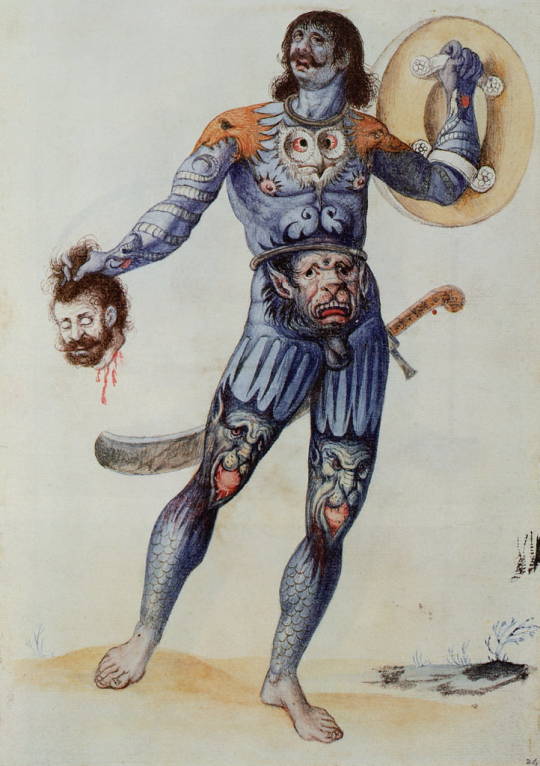
1) A Pictish woman; nude with stained and painted body, curved sword and spears. Pen and brown ink and watercolour over graphite, touched with white (discoloured). 1585-1593. John White.
2) A Pictish warrior holding a human head; nude, body stained and painted with birds, animals and serpents carrying shield and man's head, with large curved sword. Watercolour touched with bodycolour and white over graphite.1585-1593. John White.
#john white#pictish#picts#scotland#16th century art#english art#scottish art#drawing#early modern art
67 notes
·
View notes